Manchester at MIPIM 2025: Day Three Roundup
Thursday 13 March marked Greater Manchester's final day at MIPIM 2025, but that didn't slow us down. Representatives from across our region were ready to show more of our wealth of growth opportunities and the tools we have at our disposal to drive positive economic benefits for the entire region.
After a busy and productive week in Cannes, today marked the final day of MIPIM 2025, but the Manchester at MIPIM delegation wasn’t slowing down and neither was the buzz around Manchester. The region took the front page of the MIPIM Daily news and everywhere you turned, it felt let people were talking about Manchester.
MIPIM once again provided an ideal platform for our local authorities and private sector partners to meet with investors, placemakers and policy makers to discuss the many opportunities across our region and the vast amount of potential.
There was a huge buzz around the Manchester Stand once again and clear enthusiasm from delegates for our city-region's ambitious plans for growth.
Our stand programme for Thursday 13 March turned attention to the visitor economy, social value and urban regeneration outside of the city-centre and how we can use these elements as tools to drive productivity, grow the economy and creating lasting places that benefit communties.
Here’s a roundup of everything that happened on the Manchester Stand on the final day of MIPIM 2025:
A room with a view: how hospitality and leisure are shaping Manchester
The first session of the day was hosted by Victoria Braddock, Managing Director of Marketing Manchester and gave the stage to Manchester’s thriving hospitality and leisure sector. The session focused on how Manchester’s visitor economy has made strides to become an internationally renowned cultural powerhouse and discussed the new strategy that aims to maximise this, with a target to increase its economic impact to £15bn within the next 5 years.
Victoria was joined by Joel Wilkinson, Director and Co-Founder of Diecast and Nick Russell, Head of Development at Salboy.
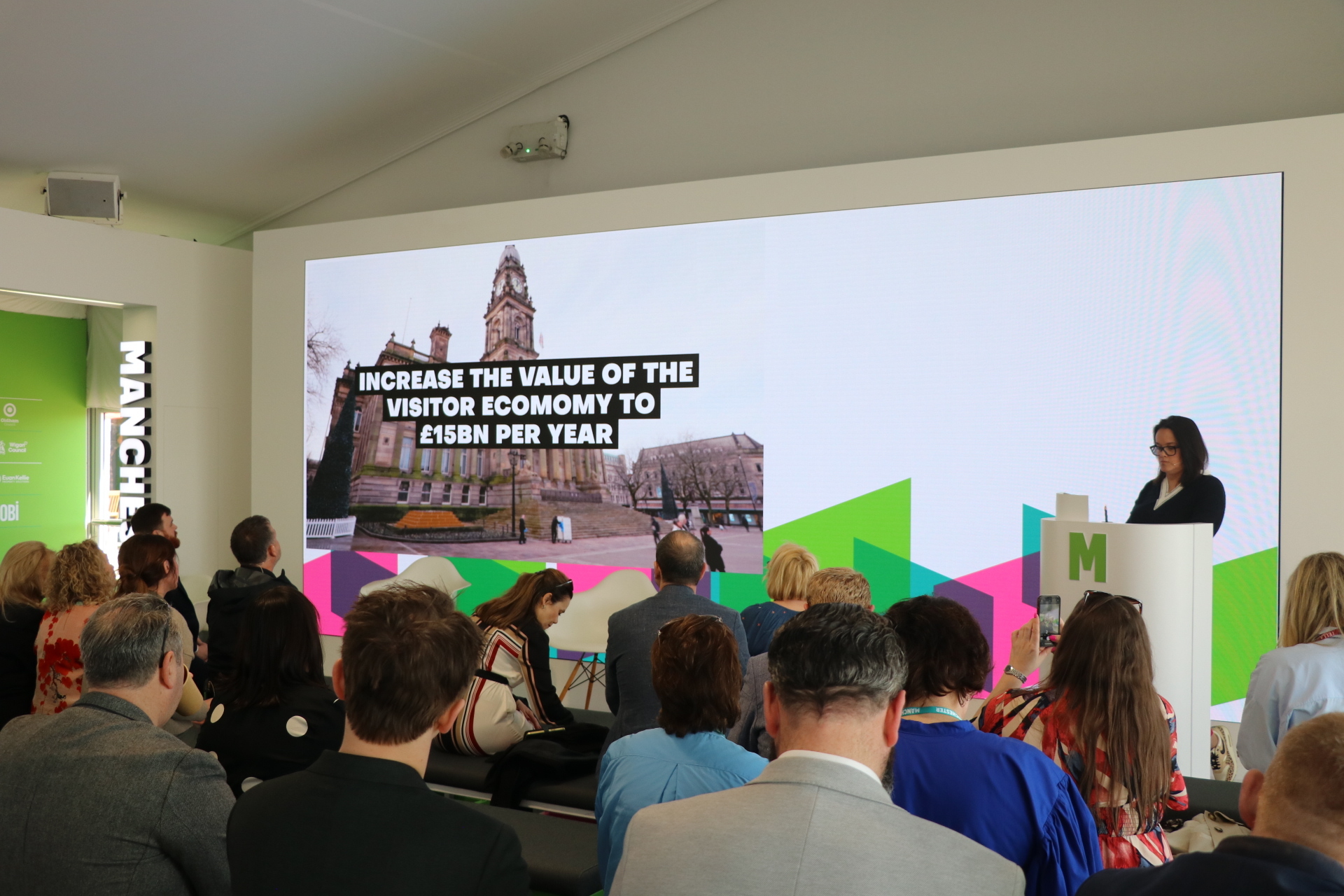
Victoria Braddock said “All week long we’ve been talking here at MIPIM about Manchester being the UK’s Growth Opportunity, and for us, the visitor economy needs to be front and centre of that. We’ve got a very ambitious strategy and we know that the visitor economy is fundamental to the future of the city-region. We want to make sure that we continue to punch above our weight.”
Nick Russell discussed their work creating a new five star hotel, W Manchester, in the St Micheal’s region of Manchester as well as the rise in branded residences to the city. He also teased the launch of a new 5 star hotel in the developer's Viadux Building, the UK’s tallest tower outside of London.
The panel went on to discuss why Greater Manchester’s visitor economy is so strong, what makes the city so special and how it can push its offer to the next level over the next five years to support economic growth.
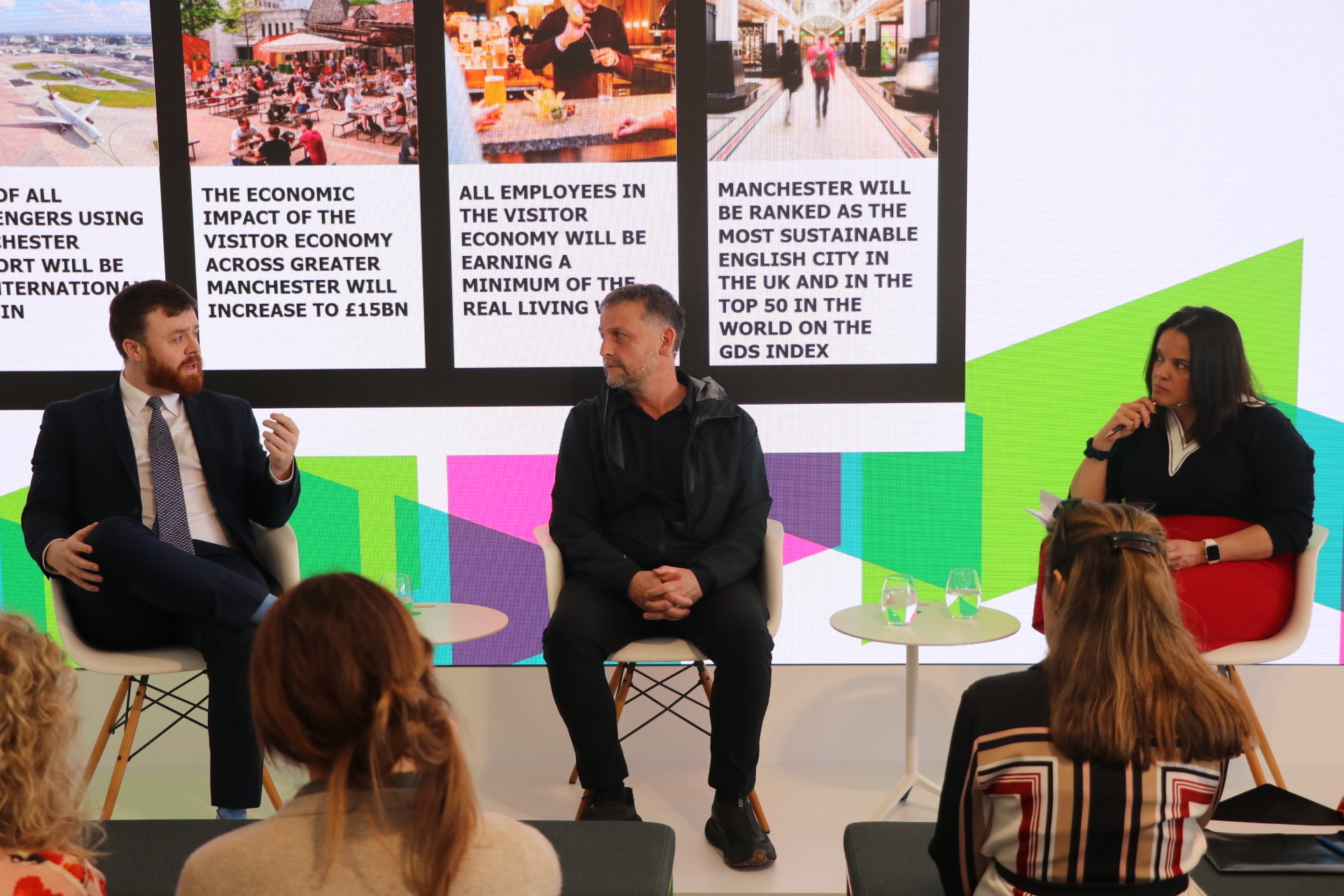
View upcoming developments and projects
With thousands of additional hotel bedrooms incoming, internationally-significant new cultural, leisure, and entertainment venues opening, a packed live events and conference calendar, and a thriving food, drink, and nightlife scene; take a look at some of the key developments and projects that will continue to reshape Greater Manchester’s visitor economy over the course of the new strategy, through to 2030 and beyond.
City to city: Embedding social impact in large-scale urban regeneration
Then it was time to look to other European Cities in a session that is always a highlight of Manchester’s MIPIM programme. The session “City to city: Embedding social impact in large-scale urban regeneration” brought together progressive city leaders, developers and thinkers to discuss the future of thriving European cities and urban regeneration.
Joining the discussion was Dan Hyde, Development Director at NOMA, Tom Stannard, Chief Executive of Manchester City Council, Audrey Peers, Head of Business Development Strategic Partnerships at MIDAS, Katerina Katerina Papavasileiou Associate Director - Real Estate ESG and Responsibility, Federated Hermes Limited and Lars Loebner Senator for Urban Development, Building and Housing, Berlin. The session was moderated by Wesley Ankrah, Director Social Value Savills.
The panel discussed the importance of providing for communities in creating lasting, thriving places and why it shouldn't be an afterthought. From providing for communities to helping draw in businesses to cities like Manchester and Berlin, the panel discussed why culture, lifestyle and community should be at the heart of all developments and masterplans.
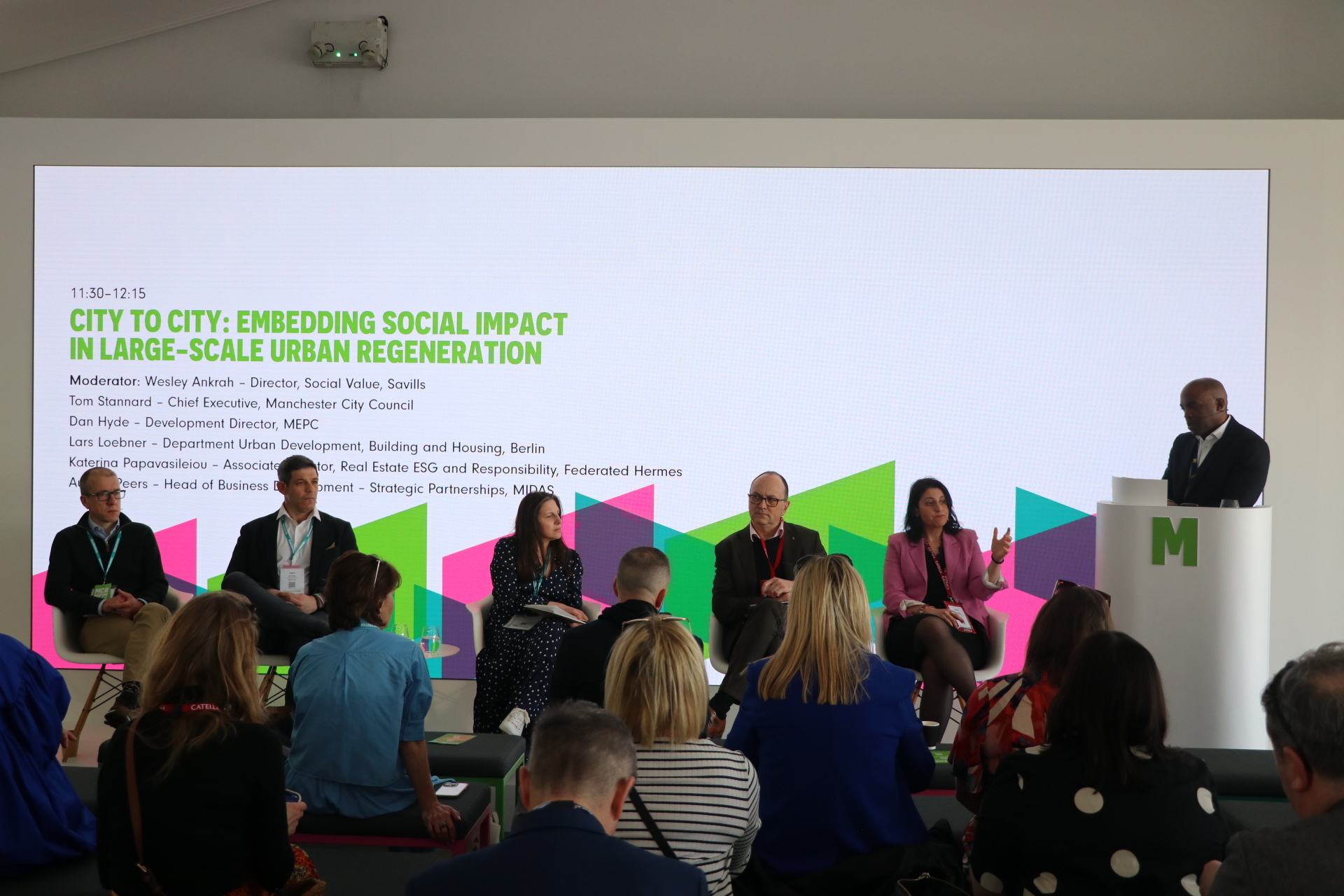
Dan Hyde said “In large urban regeneration, we're constantly looking to unlock value; financial value, economic value, environmental value but also social value. It used to be a paragraph in the business case or align on a budget sheet, but the reality is now, if you don’t deliver that you’re going to have a poorly performing scheme in the long term. It’s critical that social value is addressed through individual developments but more so in master planning.
“First and foremost it’s about listening and engaging with the community, that’s been going on for 10 plus years at NOMA. We need to engage in an authentic way, building it up over time. Everything we do at NOMA in terms of social value is analysed on a needs basis. The cookie cutter approach doesn’t work, it has to be specific to the neighbourhood.”
Tom Stannard said “I think the ingredients of a great city have to be about the development partnerships that deliver schemes on the ground but he progressive ingredient in those partnerships is making social value happen for real. NOMA is a great example of how we’ve curated this over a lot of years in Manchester, not just seeing it as a necessary stage in compliance or public procurement but as a real opportunity to add value to community development and curation.
“As well as curating the spaces which is important and often difficult and expensive, it’s the community facilities and community engagement which sit around it. The cultural side the things increases the stickiness and dwell time of places, F&B options, music particularly. Building on those connections in Manchester with our fantastic cultural scene will bring colossal opportunities.”
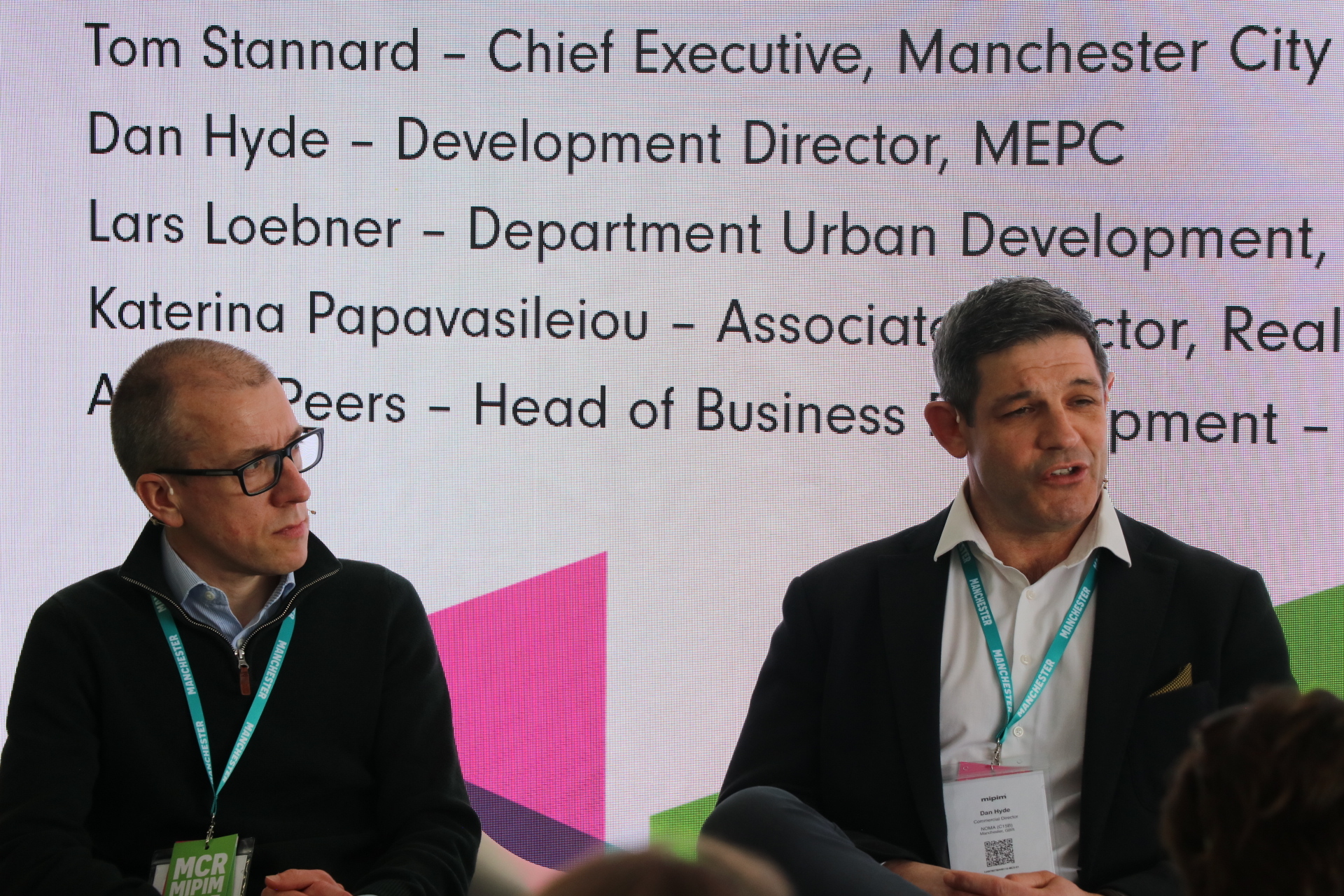
Audrey Peers said “When we attracting businesses to come to the city-region, the main question is around talent and are they going to be able to attract and retain the talent. To be able to attract that talent, these businesses need to make sure their employer brand aligns with their corporate values and the values that employees are looking for. The social and environmental element is really important nowadays. So, if we have a city region that has social values at its core - which Manchester Greater Manchester has - we can plug them into those existing initiatives and help these businesses go to neighbourhoods and clusters that demonstrate those values.”
Lars Loebner said “Berlin became famous as we had a lot of empty space and a huge urban regeneration task after the 90s. We had a huge programmes for regeneration to implement places for the community or moving public space. Berlin started with this we’re poor but sexy slogan and now it’s becoming a hotspot fo start-ups and fintechs in Germany so it’s a kind of free open space we’ve created.
“We’re now we’re facing tremendous growth in population and employment, so we are seeking new housing and have a plan to build more than 200,000 housing units by 2040. A certain part of that will be done in new neighbourhoods and the challenge is creating social value in these neighbourhoods while also connect them with the existing neighbourhoods.”

Katerina Papavasileiou said “ It’s really important to look long term. This is how areas around social value make sense financially because we're talking about reducing the risk by making sure that we create a place where you’re going to have people coming, staying and lingering and actually this increases the value of the place. From our perspective everything needs to be focused on the place that we’re developing because it’s not one-size-fits-all. Every community needs something completely different and the people who are on the ground they know what they need better than anyone”
View the livestream
Investible North: where should investors put their money?
Cllr Bev Craig joined a Place North West Panel on the UK Stage alongside Jon Dyson, Director of PLace at Bolton Council and Michael Cullen, Chief Excutive of Stockport Council called "Investible North: where should investors put their money?". Bringing together what Cllr Craig credited as "such a strong set of northern voices" the session discussed opportunities across the North to make transformational change in towns and cities. The panel aimed to highlight some of the schemes with the potential to generate a sizeable return on investment and make a real difference.
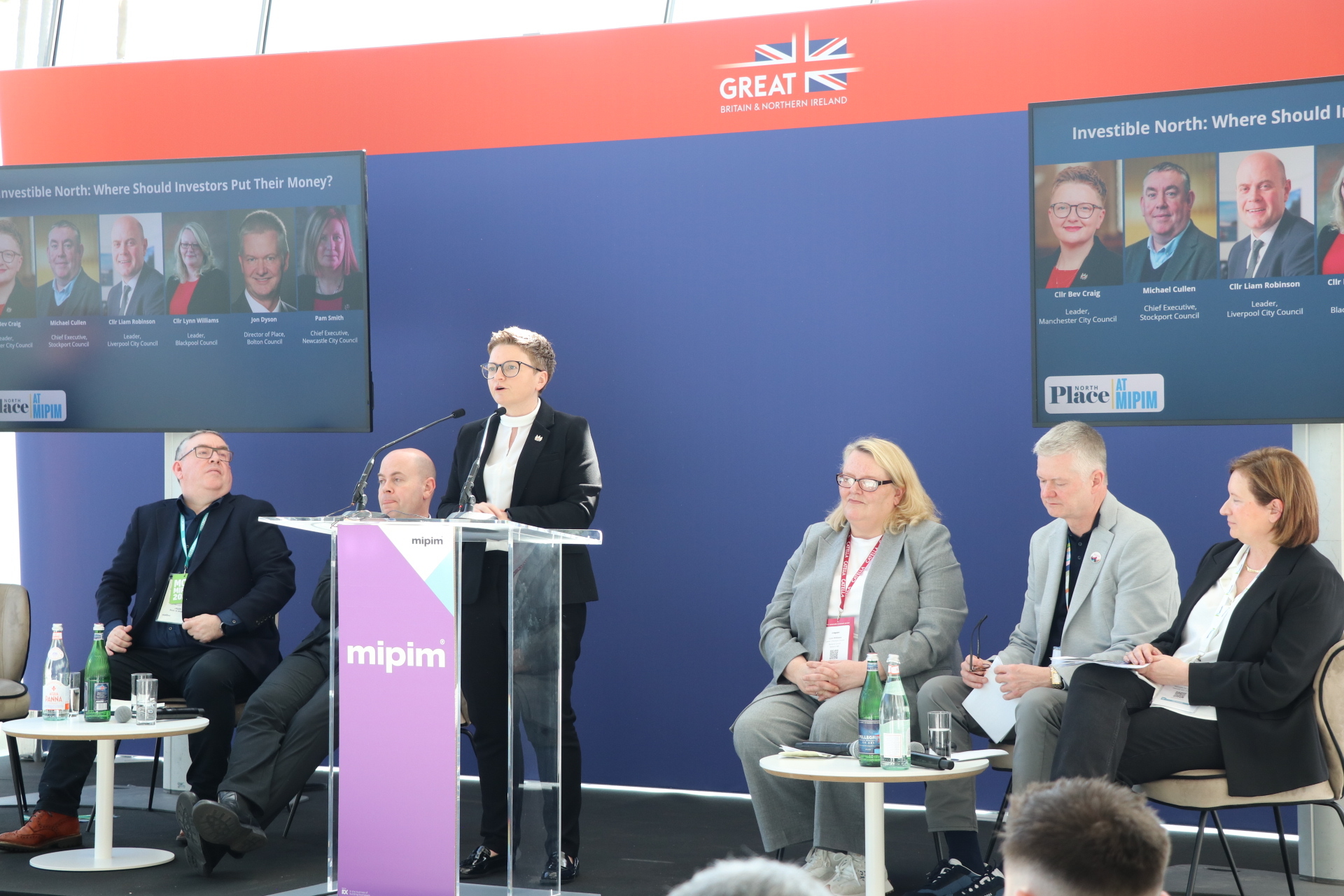
Other members of the panel included Cllr Liam Robinson, leader, Liverpool City Council, Pam Smith, chief executive, Newcastle City Council and Cllr Lynn Williams, leader, Blackpool Council.
Cllr Bev Craig commented how "the north is having an overdue moment" and the panel showed the strength of collaboration between the UK's Northern cities and towns as well as size of the opportunity.

Beyond the city centre: A pathway to inclusive growth
The penultimate session of the Manchester at MIPIM programme for 2025 was all about driving growth outside of the city centre, turning attention to boroughs and the strength of Mayoral Development Zones. The session brought together local authorities and developers to discuss how Manchester’s unique devolved powers can create new partnerships and unlock development opportunities at scale in their growth locations.
Joining moderator Evelina Grecenko Senior Reporter at Estates Gazette was Andrew McIntosh, Director of Place at Greater Manchester Combined Authority, Nicola Elsworth Assistant Director Investment Development & Housing at Tameside Council, Richard Roe Corporate Director of Place at Trafford Council and Richard Knight Director of Strategy and Planning at Peel Land.
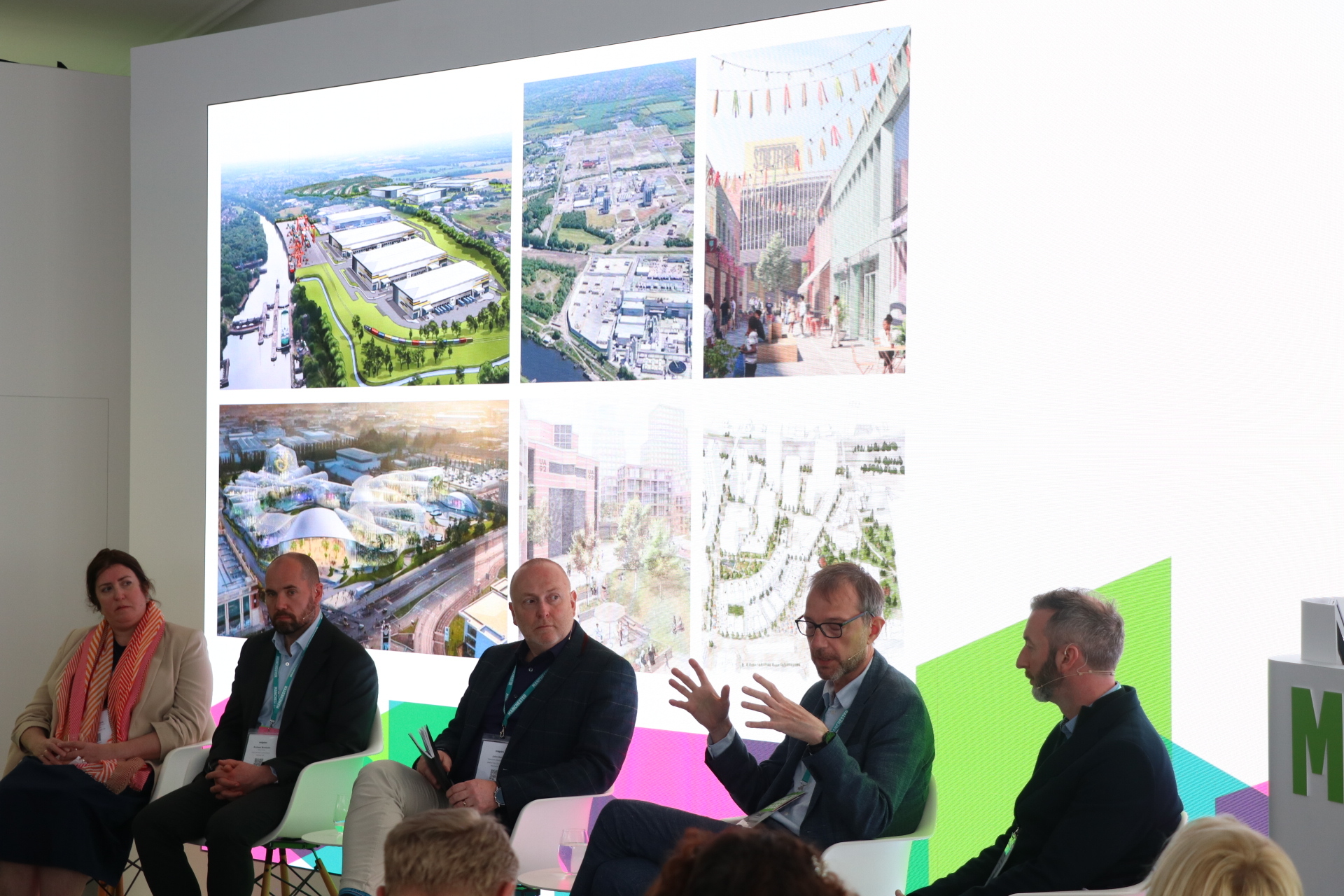
Andrew McIntosh began the presentation an overview of Mayoral Development Zones, what they mean for Greater Manchester and how they can best be utilised.
Andrew McIntosh said “With all three local authorities represented here being part of the Mayoral Development Zones, it gives us the ability to have a voice to government to set out what we can deliver within Greater Manchester and hopefully attract inward investment. We need a mechanism that that brings both local and national public bodies together alongside private developers to accelerate delivery within the Mayoral Development Zone areas. It really is about collaboration and that partnership approach. We can collectively set a joint aim and try and maximise delivery in relation to the Greater Manchester strategy. It’s hopefully a powerful vehicle for driving that forward”
Nicola Elsworth outlined the role of the Eastern Growth Cluster, which covers Tameside. She highlighted opportunities in the Ashton Mayoral Development Zone and how it can be used to drive inclusive growth through Ashton Town Centre, as well as build on the success of St Petersfield, Ashton Old Baths as a business hub. She also commenbted on the strength of the colleges in Tameside and close knit business network.
Nicola Elsworth said “The ability for us to bring quality jobs and quality employment is as a real key driver to what we can achieve locally in Ashton. It is also about inclusive growth and making sure local people, young people can take advantage of the opportunities that are presented here.”
John Searle then gave an overview of Salford’s priorities as part of the Western Gateway development zone. He discussed the massive opportunity around Port Salford, a multimodal port creating vast employment space. He also touched on the repurposing exercise of Eccles town centre, focusing more on residential, food, beverage and leisure offers rather than creating another retail hub. Then he touched on the project at the Salford Community Stadium and how it will bring wider sports and leisure opportunities to the area to support the stadiums longevity as well as help grass root level sports.
John Searle said “It’s important to say that this isn’t coming from a standing start, this has already been ongoing for some time. The MDCs are fundamentally about collaboration for me and also a spotlight to kind of rebrand it a little bit. This is a reinvigorating exercise. From Salford’s perspective we’re focusing on Port Salford and the expansion of that site that adds up to over half a million square metres of employment space, real opportunity.”
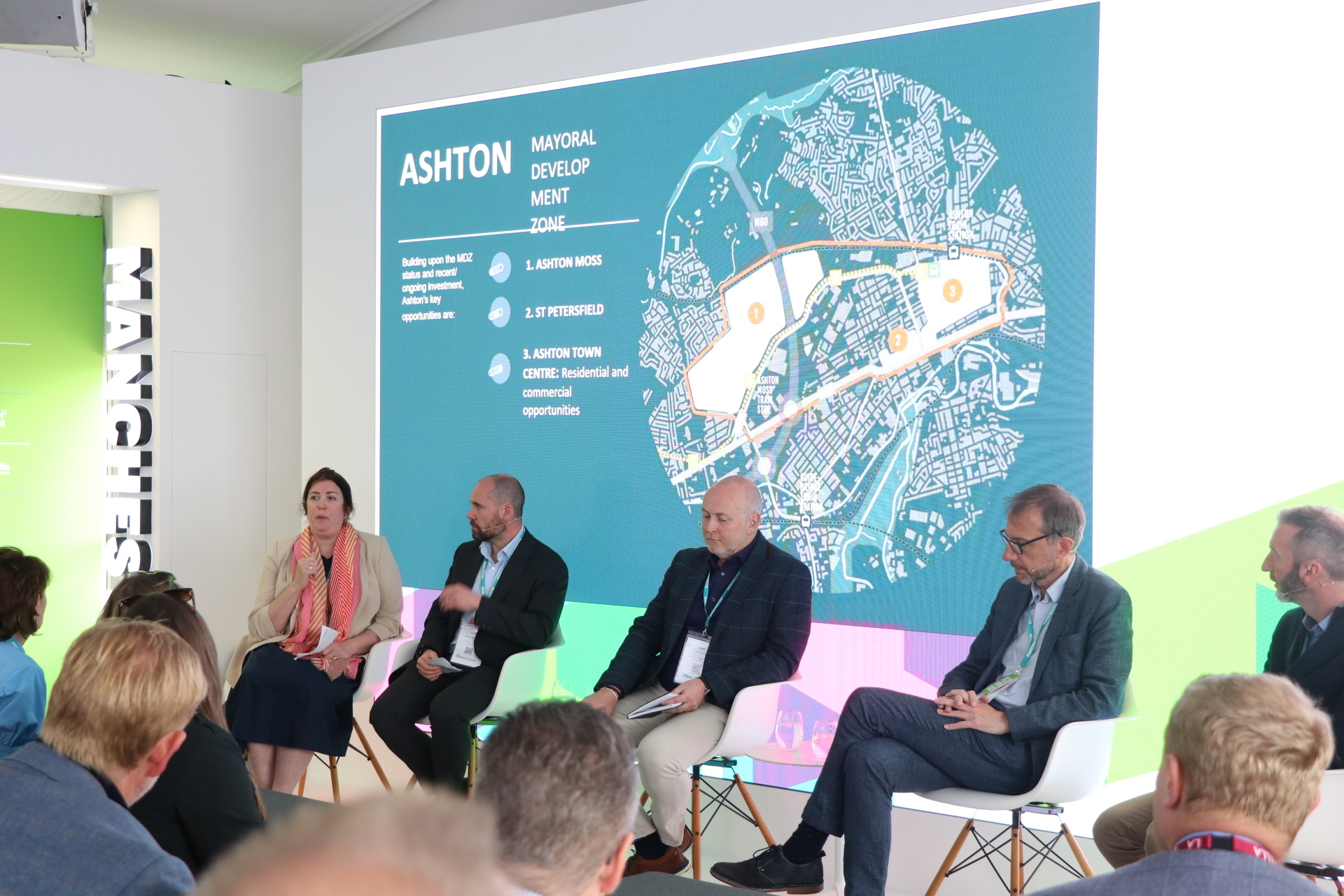
Richard Roe gave an overview of Trafford’s priorities highlighting that although an incredibly exciting opportunity, the Old Trafford Regeneration is not the only opportunity within the Western Gateway. He discussed how the growth location will support Partrington, one of Trafford’s more deprived communities as well as support the ongoing regeneration of Stretford Town Centre, Carrington and major infrastructure works on the Kingsway – a leading route into Manchester City Centre. He also discussed plans for 3,000 residential units in Trafford Waters and investments in Trafford City, the home of the Trafford Centre to create a world-leading leisure destination.
Richard Roe said “One of the things that’s interesting about the western gateway is that there is so much delivery already going ahead. This is a significant amount of investment and development that has taken place and is now starting to quite quickly come up against the crunch point in terms of the need for investment into infrastructure add to unlock the rest of the development potential.
“What makes western gateway so unique is stretching its reach from Old Trafford and the edge of the regional centre out West to the edge to Partington which is one of Trafford’s more economically deprived and challenged communities. It’s about how we can drive investment and involvement through the Western Gateway that delivers growth, delivers housing, but also improves access and infrastructure into our more deprived communities so that they are able to access the jobs we’ve created .”
Richard Knight gave a private sector investor’s perspective on the mayoral development zones, and gave a walk through presentation of the Western Gateway. This gave audience members the chance to visualise Trafford Waters, Port Salford, and The Trafford City area as well as show infrastructure upgrades to freight and motorway networks.
Richard Knight said “I think we’re probably 30 to 40 years in with delivery in some of the initiatives have been mentioned so the Peel Group has taken a long term approach to that, some of challenges that have been mentioned around infrastructure in particular are limiting the pace at which we can continue and move forward. So the emergence of the growth location and off the back of that the mayoral development zones to bring a new single view and solutions to those challenges is very much timely and welcome. We’re hopeful that with that approach, we can work through those issues.”
View the livestream
In conversation …Michael Ingall
For Manchester’s final stand session at MIPIM 2025, Michael Ingall - the visionary investor and developer behind Spinningfields, Enterprise City, St Johns and Campfield took to the stage. Michael discussed whether now could be a time to create a global story around Manchester, and if not now, when would the right time be?
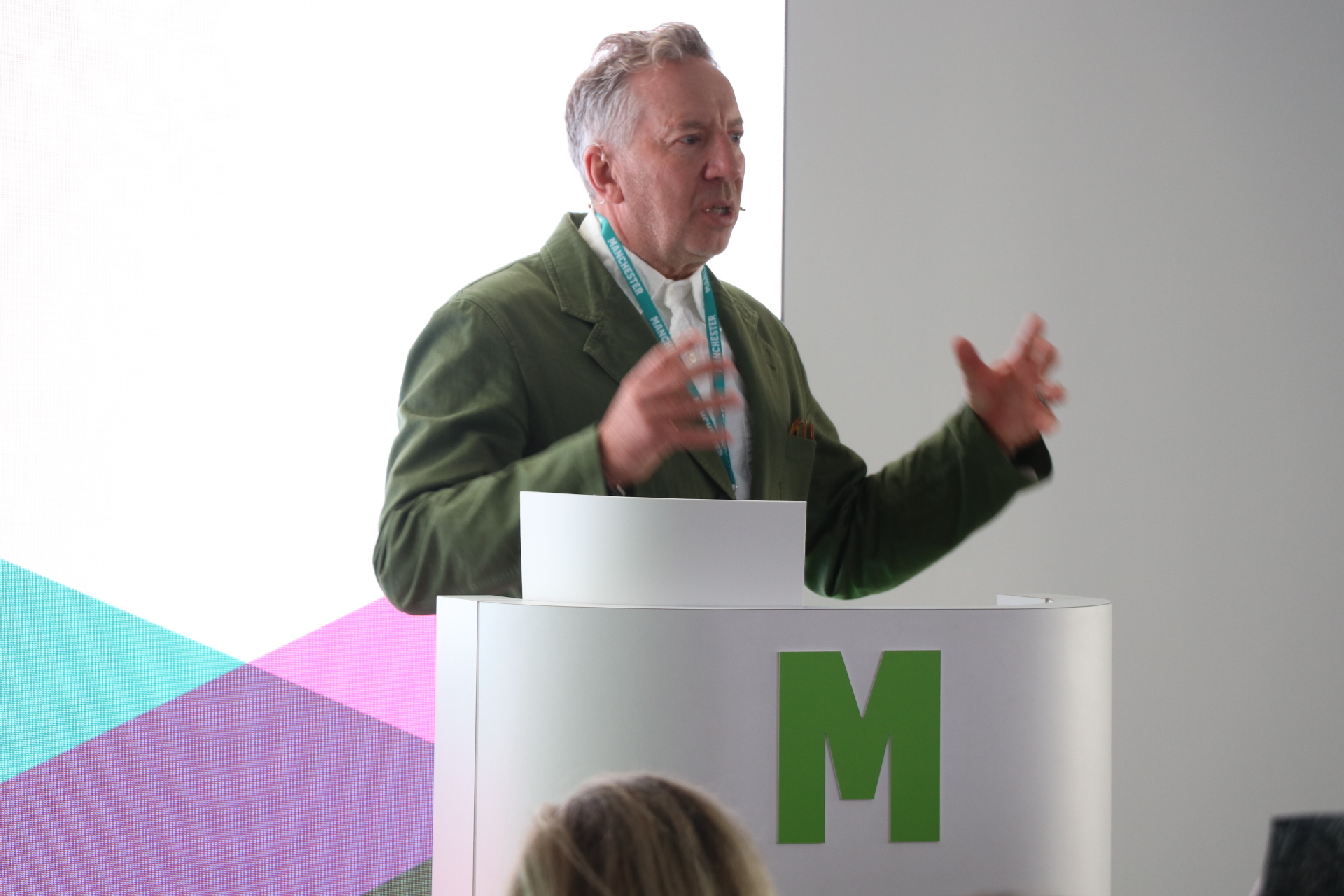
Michael discussed Manchester’s past, its role as a global city and how it can be a place where businesses thrive by building the innovative spaces that attracts key sectors. He also commented on the region’s 10-year growth plan and ambitions to drive growth across the entire region, making the most of Greater Manchester’s individual strengths and assets.
Micheal Ingall said “You’ve got to have a story. Manchester has had a story for the last 25 years, but I feel at this MIPIM the story has pivoted from Manchester’s City Centre to Greater Manchester. That’s the political message. It’s about community.
“The way Greater Manchester will now be built is innovative, the way we’re going to deliver the 10 year growth plan is innovative. The whole region is booming, that’s the sort of innovation at the macro scale that we’re promising this year. We’ve got a story, we’ve got a track record, we are investable. With Greater Manchester rather than just investing in the real estate you're investing in a region.”
Michael also announced his plans for the Campfield Mega Campus, a globally recognised tech hub which will support thousands of startup businesses, launching in St John's April 2025. The 160,000 sq ft of incubator space will host “Exchange” an innovative tech incubator which is currently on its on 9th cohort. So far the programme has supported 142 different startups with alumni raising £86m after leaving the incubator.
View the livestream
As MIPIM now draws to a close, we’d like to thank all of our partners for joining us and helping us present Manchester as The UK’s Growth Opportunity on the world stage.
Thanks to our strategic partners Greater Manchester Combined Authority and Manchester City Council for working closely with us to deliver this programme.
Thanks to MIDAS for sponsoring our event and working closely with us to position Manchester as a leading place to do business, including through their new Investment Prospectus.
It was a huge privilege to have all 10 Greater Manchester Local Authorities in attendance, marking the strength of collaboration across geographies in Greater Manchester as well as the shared ambition to drive inclusive growth across all 10 boroughs - Bolton Council, Bury Council, Oldham Council, Manchester City Council, Rochdale Borough Council/Rochdale Development Agency, Salford City Council, Stockport Council, Tameside Council, Trafford Council, Wigan Council.
And of course, thank you to all of our partners for coming together and showing a strong voice and acting as real ambassadors for our region; Avison Young, Axis Re Limited, Civic, FEC Development Management Ltd, MADE Partnership, MIX MANCHESTER, Muse, Peel Land, R Salboy, SimpsonHaugh Architects, Bruntwood, Deloitte LLP, Mansell Building Solutions, Allied London, Arup, AtkinsRéalis, Diecast B10, EPR Architects, Euan Kellie Property Solutions, JLL, Laing O'Rourke, LIVINGWAY, Lovell Partnerships, Mayfield, NOMA, Northwest Evergreen Fund, OBI, Ocean Media Group, Old Trafford Regeneration, Regeneration Brainery, Renaker, Savills (UK) Limited, Step Places, Victor at MC Construction, Views.
We look forward to seeing you all at MIPIM next year as part of the official Manchester Delegation.